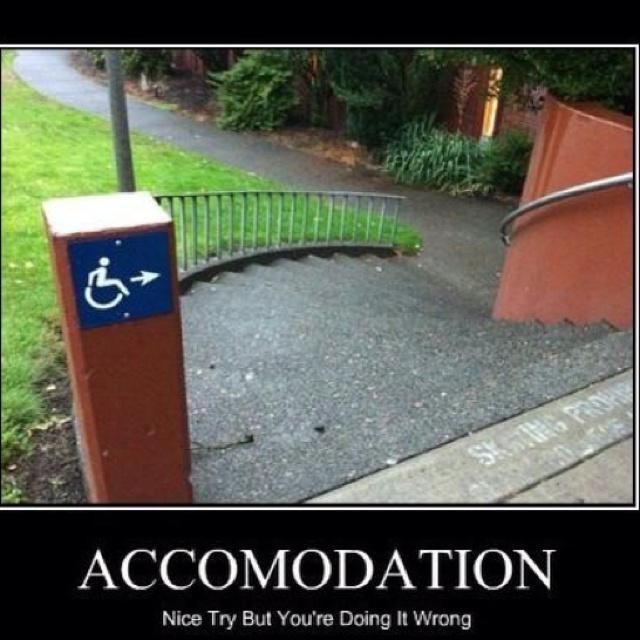Further to my first post about the free online course ‘User Experience for the Web’, you can read here some notes about its module 1: Overview of User Experience.
Besides, here is a quiz with 8 questions. I hope you will find it usable…
Module 1: Overview of User Experience
Topic 1: Introduction
UX is multidisciplinary:
- Graphic design
- Psychology
- Research
- Anthropology
=> It is all about end-user, user behaviour.
What impacts User Experience for a website?
- content
- tone / language
- usability
- branding
- look and feel
- images
- processes
Topic 2: The Evolution of UX as a discipline
=> Helping to bridge the gap between the customer / end-user and the business
Topic 3: Usability
Usability is about efficiency of use, ease of use, and satisfaction. This is a subset of User Experience.
Here is an example of bad usability:
There is an international standard for usability: it is ISO 9241 part 11 “Ergonomic requirements for office work with visual display terminals (VDTs)”. This standard talks about
- user
- task
- equipment
- environment
Improving usability requires to involve users, via the methodology known as User Centered Design: it’s about putting the user at the centre of the design process.
Topic 4: User centered design
UCD = User Centered Design
There are 3 cores to UCD:
- 1st phase is about research:
- understanding user needs with few techniques
- understanding business objectives, what they are trying to achieve
- 2nd phase is design with 3 core elements:
- information design: designing the information and content
- interaction design: how the user interacts with the content
- visual design: putting the layer of the look and feel of the website together
- 3rd phase is evaluation: bringing users in to test the design or bringing usability experts to review the design
Here are benefits of the UCD:
- scalable
- flexible
- repeatable
There is also an ISO standard for human centered design: ISO 9241 – Part 10 “Human-centered design for interactive systems”. It contains 6 key principles:
- It’s about users’ tasks and environment
- Users are always involved in the process
- The fact that the design is driven and refined through evaluation
- It’s an iterative process
- It addresses the whole user experience
- The team is multidisciplinary
Bonus: Have a look to these very useful User-Centered Design Basics.
Topic 5: Factors affecting interface design
5 (factors) core elements influence user interface:
- Users: who are they, where are they, what are their goals?
- Tasks: why are they performing these tasks? why are they visiting the website?
- Environment: are they in a public transport or in a busy office completing their task?
- Platform: what device are they using completing their task: tablet, mobile phone?
- Business need: business objectives and goals: are they trying to generate revenue? Are they delivering a service? Are they to increase engagement with the user?
Topic 6: Users, business and balancing the needs of both
The key about User Centered Design process is observation. Because what users say is not necessarily what they do (example of the yellow and black Sony Walkman device).
The business needs are what does the business want to achieve:
- generate revenue
- political reasons
- engage their customers
- providing a service to end users
A good user experience balance the needs of both business and the users to provide the best outcome.
Topic 7: UX versus similar disciplines
UX can overlap with other disciplines:
- Web design
- Advertising
- Business analysis
- Strategy
- Social science
- Market research
- Graphic design
- Website and system development
And which difference with Customer Experience?
- UX = all about all aspects of an experience a user has with a single product or service.
- CX goes up one level. This is about the customer (consumer) and all her/his experience with the product
- Service design = looking at a holistic service an organisation provides to its customers. So everything from the website to mobile app
Topic 8: Characteristics of a UX-er
Characteristics of user experience practitioner:
- communicate clearly about research, design, findings and evaluation
- open mind, because sit between business and user, need to look to every perspective before making a decision
- understand the design of the technology
- be a problem-solver
- put the users first
- be flexible
- understand behaviours
Reminder: there is a quiz with 8 questions to test your knowledge.
And if you feel really comfortable with these first topics, perform the 10 questions assessment for module 1.
Feel free also to have a look at these other posts:
- Online course ‘User Experience for the Web’ – module 2 – The Elements of User Experience
- Online course ‘User Experience for the Web’ – module 3 – Knowing your users
- Online course ‘User Experience for the Web’ – module 4 – Usability Evaluation Techniques


4 thoughts on “Online course ‘User Experience for the Web’ – module 1”